
Basava (1131–1196), also called Basavēśvara and Basavaṇṇa, was an Indian philosopher, poet, Lingayat social reformer in the Shiva-focused bhakti movement, and a Hindu Shaivite social reformer during the reign of the Kalyani Chalukya/Kalachuri dynasty. Basava was active during the rule of both dynasties but reached the peak of his influence during the rule of King Bijjala II in Karnataka, India.

Nizam of Hyderabad was the title of the ruler of Hyderabad State. Nizam is a shortened form of Niẓām ul-Mulk, which means Administrator of the Realm, and was the title bestowed upon Asaf Jah I when he was appointed Viceroy of the Deccan by the Mughal Emperor Farrukhsiyar. In addition to being the Mughal Viceroy (Naib) of the Deccan, Asaf Jah I was also the premier courtier of the Mughal Empire until 1724, when he established the independent monarchy of Hyderabad and adopted the title "Nizam of Hyderabad".

Mir Osman Ali Khan, Asaf Jah VII was the last Nizam (ruler) of the Princely State of Kingdom of Hyderabad, the largest state in British India. He ascended the throne on 29 August 1911, at the age of 25 and ruled the Kingdom of Hyderabad between 1911 and 1948, until India annexed it. He was styled as His Exalted Highness (H.E.H) the Nizam of Hyderabad, and was widely considered one of the world's wealthiest people of all time. With some estimates placing his wealth at 2% of U.S. GDP, his portrait was on the cover of Time magazine in 1937. As a semi-autonomous monarch, he had his mint, printing his currency, the Hyderabadi rupee, and had a private treasury that was said to contain £100 million in gold and silver bullion, and a further £400 million of jewels. The major source of his wealth was the Golconda mines, the only supplier of diamonds in the world at that time. Among them was the Jacob Diamond, valued at some £50 million, and used by the Nizam as a paperweight.

Paigah family was a noble family from the former Hyderabad State. The family maintained their own court, individual palaces, and a standing army of about fourteen thousand infantry and cavalry troops.
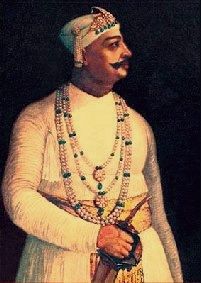
Nawab Mir Akbar Ali Khan Siddiqi Bahadur, Sikander Jah, Asaf Jah III, was the 6th Nizam/Ruler of Hyderabad, India from 1803 to 1829. He was born in Chowmahalla Palace in the Khilwath, the second son of Asaf Jah II and Tahniat un-nisa Begum.
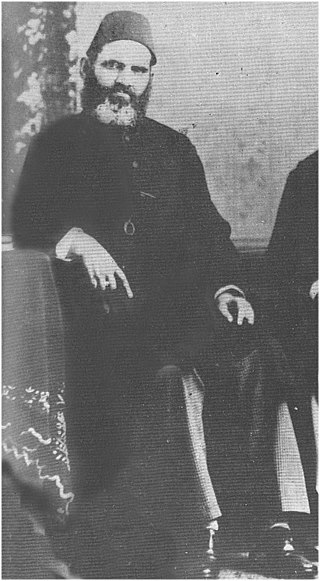
Nawab Mohsin-ul-Mulk, Munir Nawaz Jang, also known as Syed Mehdi Ali, was an Indian Muslim politician. He was a close friend of Syed Ahmed Khan, was involved in the Aligarh Movement and was one of the founders of the All India Muslim League in 1906.

Muhammad Yusuf Khan was a commandant of the British East India Company's Madras Army. He was born in a Tamil Vellalar clan family in a village called Keelapanaiyur in British India, what is now in Mudukulathur Taluk, Ramanathapuram District of Tamil Nadu, India. He converted to Islam and was named Muhammad Yusuf Khan. He was popularly known as Khan Sahib when he became the ruler of Madurai. He became a warrior in the Arcot troops, and later a commandant for the British East India Company troops. The British and the Arcot Nawab employed him to suppress the Polygar uprising in South India. Later he was entrusted to administer the Madurai country when the Madurai Nayak rule ended.

The Carnatic Sultanate was a kingdom in South India between about 1690 and 1855, and was under the legal purview of the Nizam of Hyderabad, until their demise. They initially had their capital at Arcot in the present-day Indian state of Tamil Nadu. Their rule is an important period in the history of the Carnatic and Coromandel Coast regions, in which the Mughal Empire gave way to the rising influence of the Maratha Empire, and later the emergence of the British Raj.

Moula-Ali commonly known as Moula Ali. It is a well-developed industrial and urban area in Malkajgiri Mandal, of the Medchal-Malkajgiri district, It is a part of Greater Hyderabad and also a part of Hyderabad Metropolitan Region of the Indian state of Telangana, This area is well connected with rail transportation through the Moula Ali Railway Station. It is noted for its Moula Ali hill, on top of which stands the Moula Ali Dargah and mosque, dedicated to Ali.

The Asaf Jahi was a Muslim dynasty that ruled the Hyderabad State. The family came to India in the late 17th century and became employees of the Mughal Empire. They were great patrons of Persian culture, language, and literature, and the family found ready patronage.

Paigah Tombs or Maqhbara Shams al-Umara, are the tombs belonging to the nobility of Paigah family, who were fierce loyalists of the Nizams, served as statespeople, philanthropists and generals under and alongside them. The Paigah tombs are among the major wonders of Hyderabad State which are known for their architectural excellence as shown in their laid mosaic tiles and craftsmanship work. Since it was Amir-e-Kabir H.E. Nawab Sir Khursheed Jah Bahadur who built the Paigah Tombs, he gave special preference in terms of construction to his immediate family. Of all the arches at Paigah Tombs, it is only the arch of his family's tomb that is bigger when compared with others. the entire necropolis was built earlier then the architecture would have been the same for all the tombs but instead in terms of architectural beauty, the tomb of Nawab Sir Khursheed Jah's family was given special preference. The largest arch and the double maqbara inside known as "Mahajar" cannot be seen inside any other tomb and also to mention the beautifully decorated stucco work in the tomb of Lateefunnisa Begum Saheba is not found in any other tomb. The tombstone of Lateefunnisa Begum Saheba, on which is already mentioned was built by Nawab Sir Khursheed Jah Bahadur. "Lateefunnisa Begum Saheba Jid'de Mohammed Mohiuddin Khan Khursheed Jah Tayyari ye Mohammed Mohiuddin Khan Khursheed Jah Bahadur." The word "Jid'de" over here would mean Grandmother of Sir Khursheed Jah Bahadur and "Tayyari'ye Mohammed Mohiuddin Khan Khursheed Jah Bahadur" would mean "Prepared by Khursheed Jah Bahadur." Inside this tomb are the graves of Nawab Sir Khursheed Jah Bahadur's immediate family members. Shahzadi Hussainunnisa Begum (Wife), Shahzadi Hashmatunnisa Begum (Mother), Amir-e-Kabir Nawab Mohammed Rasheeduddin Khan Bahadur (Father) and Hussaini Begum. The Paigah's necropolis is located in a quiet neighbourhood 4 km southeast of Charminar Hyderabad, at Phisal banda suburb, down a small lane across from Owaisi Hospital near Santosh Nagar. These tombs are made out of lime and mortar with beautiful inlaid marble carvings. These tombs are 200 years old and represent the final resting places of several generations of the Paigah Nobles.

Amberpet is one of the oldest suburbs of Hyderabad, India. Amberpet lies adjacent to the famous Osmania University. It is also a Mandal in Hyderabad District. Its area stretches from Kachiguda to Ramanthapur in the East, and from 6 NO TO MALAKPET in the South. One of the oldest area of, Hyderabad, India.

Mir Alam Ali Khan, also known as Nawab Alam Yar Jung Bahadur, was an Indian judge and politician.
Basavakalyana fort, earlier known as Kalyana fort, is located in Bidar district in the Indian state of Karnataka. Its historic importance is dated to the 10th century. The capital of Chalukyas was also shifted from Manyakheta to Kalyana in the 10th century. The fort, integral to the Basavakalyana town, is also famous as Karmabhoomi of Basavanna and hundreds of other Sharanas.
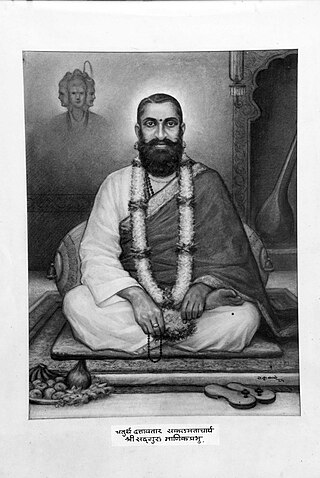
Manik Prabhu Maharaj was an Indian Hindu saint, philosopher, poet and guru. He is also regarded as an incarnation of Dattatreya by the people of Datta Sampraday. Prabhu's philosophy, the Sakala mata Siddhanta rests on the principles of Advaita Vedanta as propagated by Adi Sankara. Shri Prabhu strongly advocated the essential oneness of all religions. Prabhu's Muslim devotees revered him as an incarnation of Mehboob Subhani whereas his Lingayat devotees saw him as a form of Basavanna. Shri Prabhu composed numerous bhajans and padas in various languages such as Marathi, Kannada, Hindi, Urdu and Sanskrit. Shri Prabhu was also associated with the First War of Indian Independence in 1857. Shri Sai Baba of Shirdi, Shri Swami Samarth of Akkalkot, Shri Bramhachaitanya of Gondavale and many other contemporary saints are believed to have visited Maniknagar to interact with Prabhu on matters of deep spiritual wisdom. Biographers refer to Shri Prabhu as a saint of great spirituality and mysticism. Shri Prabhu's teachings emphasize the path of Bhakti. He also moralized on the vedantic truths concerning the spiritual unity of beings. Manik Nagar, Humnabad, Bidar District is the place where he took sanjeevani samadhi. Shri Prabhu's samadhi at Maniknagar is the nucleus of Manik Nagar and acts as the spiritual center of the activities of Shri Manik Prabhu Samsthan.
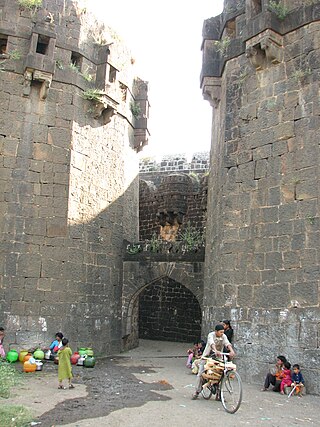
Naldurg Fort is a historic fort in Naldurg town of Osmanabad district in Maharashtra state of India. Naldurg Fort is named after Nalraja who built the fort in medieval architectural style. The unique feature of the fort is that it encloses a knoll of basalt rock which juts out into the valley of the small Bori River and a long fortification wall with many bastions. The Naldurg fort is one of the important ground forts in the Marathawada region. It represents a fine example of the medieval architectural style. Naldurg which was formerly a district headquarter is situated about 50 Kms. south-east of Osmanabad. The fort which is an interesting place has enclosed a surface of a knoll or plantain of basalt rock which is jutted out into the valley or raving of the small river Bori. Along the rest of the cliff on three sides ran fortifications. bastion firmly built out have deseed basalt and are large enough to carry heavy guns. The entire circumference is about a mile and a half. The interior portion is covered with ruined walls and a half, the interior portion is covered with ruined walls and a vide road running up to the centre. The fort has many bastions amongst which are upli Buruj, which is the height point in the fort paranda Buruj, nagar Buruj, Sangam Burug, Sangram Buruj, Bands Buruj, poone Buruj, etc. Inside the fort there are remains of the walls and some of the building such a Barood kotha, Baradari, Ambarkhana, Rangaan mahal, Jali etc. Though the buildings are in ruins the remains give a impression that there night have been at one time the specious buildings, There are two tanks in the fort known as machali guns amongst which important are the “hathi toph” and magar Toph”, The hathi Darwaza and the hurmukh and the hurmukh darwaza are the main gates of the fort. The most interesting building which connects the fort and the Ranmandala is the dam constructed across the bori river, the dam and the” pani mahal, which is built underaatch and in the middle of the dam were, constructed. During the reign of Ibrahim Adil shah II In 1613. It is believed that the fort was built by Nalaraja. The fort and the city is named after him. The fort was built in the period of the Chalukya kings of Kalyani. Later, from 1351 to 1480,in the period of the [Bahamani] kings and in 1558, the Adil Shahi rulers, After the down fall of Adil Shahi Kingdom Naldurg passed in the hands of moghalain the year 1686.A.D. Nizam ul Mulk Asif Jah Was appointed as Governor of Entire Deccan from Central India & Gujrat up to kanya kumari .After the death of Aurangzeb Nawab Nizam ul Mulk Asif Jah Bahadur founded the Nizam Dominion During the time of II Nizam The Governor (Subedar) became Rebel and Causing Havoc to the Subject Then the Asif Jah II ,Nawab Nizam Ali khan send his Afghan General Mohammed Dulah Khan. General Mohammed Dulah Khan Conquered the province Crushed the mutiny and taken the traitor in his custody .Nizam the II Appointed Nawab Mohammed Dulah khan Bahadur as a Governor (Subedar) with the Title of Nawab Karar Nawaz Jung Bahadur. Then his Son Nawab Amir Nawazul Mulk Bahadur became the Governor of Naldurg. He Ruled Very Successfully, He was not only kind hearted but generous when the theft of 1 1/2 Quintal Gold from the Tulja Bhawani Temple He Donated the Gold from his personal treasure as to compensate. The most Important Historical Marriage which took place at Naldurg Fort at Rang Mahal Was The Marriage of Chand Bibi Sultana .This wedding took between the two Kingdoms Adil Shahi and Nizam Shahi The Makhbara(Shrine) of Nawab Amir Nawazul Mulk Bahadur & Beside him Princess Fakharunnisa Begam Daughter of Nizam ul Mulk II Mazars are at Naldurg Where not only the people of Naldurg but of entire Marathwada people visit the shrine to Pay respect to their Late Ruler. After Death of Nawab Sahab His Successors became the Governor upto 1948. The present Successor's are his 5 legal heirs & their legal heirs hailing in Hyderabad, Telangana who visit these places quite often as they are having the sentimental love & affection with there soil & people of Naldurg and hold quite Acres of Land in Naldurg and surrounding cities in Maharashtra. The fort location en route Solapur from Bijapur-Bidar made it a strategic investment. Medieval architecture and engineering techniques from the period are signature styles of this citadel.

Durgadi Fort is a fort located in Kalyan, near Mumbai in Maharashtra, India.
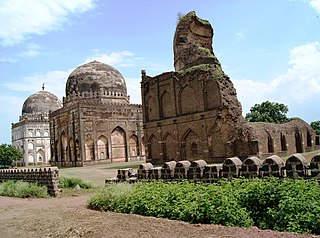
The Bahmani tombs complex at Bidar is the necropolis of the Bahmani dynasty, located in Bidar, in the Indian state of Karnataka.
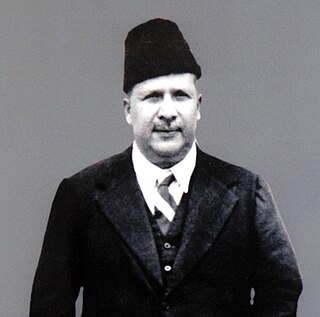
Amir Ali Khan was one of the four Subedars in the Hyderabad district during the erstwhile Nizam's rule.

Amir-e-Paigah-e-Asman Jahi, Moin-ud-Daula Bahadur Innayath Jung, commonly known as Sir Nawab Muhammed Moin Uddin Khan born at Basheer Bagh Palace in 1891 was an Indian nobleman and member of the Paigah Nobility and the Amir of the Asman Jahi Paigah one of the 3 great Paigahs of Hyderabad State The Paigah Nobility was the second most powerful family in Deccan Hyderabad State maintaining their own court and army bound with Asaf Jahi dynasty by matrimonial relationship, Moin-ud-doula and his father Asman Jah was one of those fortunate individuals to whom it has been given by fate to write their names large in the annals of their country, Moin-ud-doula's father Asman Jah who served as co-regent and Prime Minister of Hyderabad created several marvelous architects throughout the city maintained his army court in his domain Shamshabad, was granted the title of Order of the Indian Empire,





















